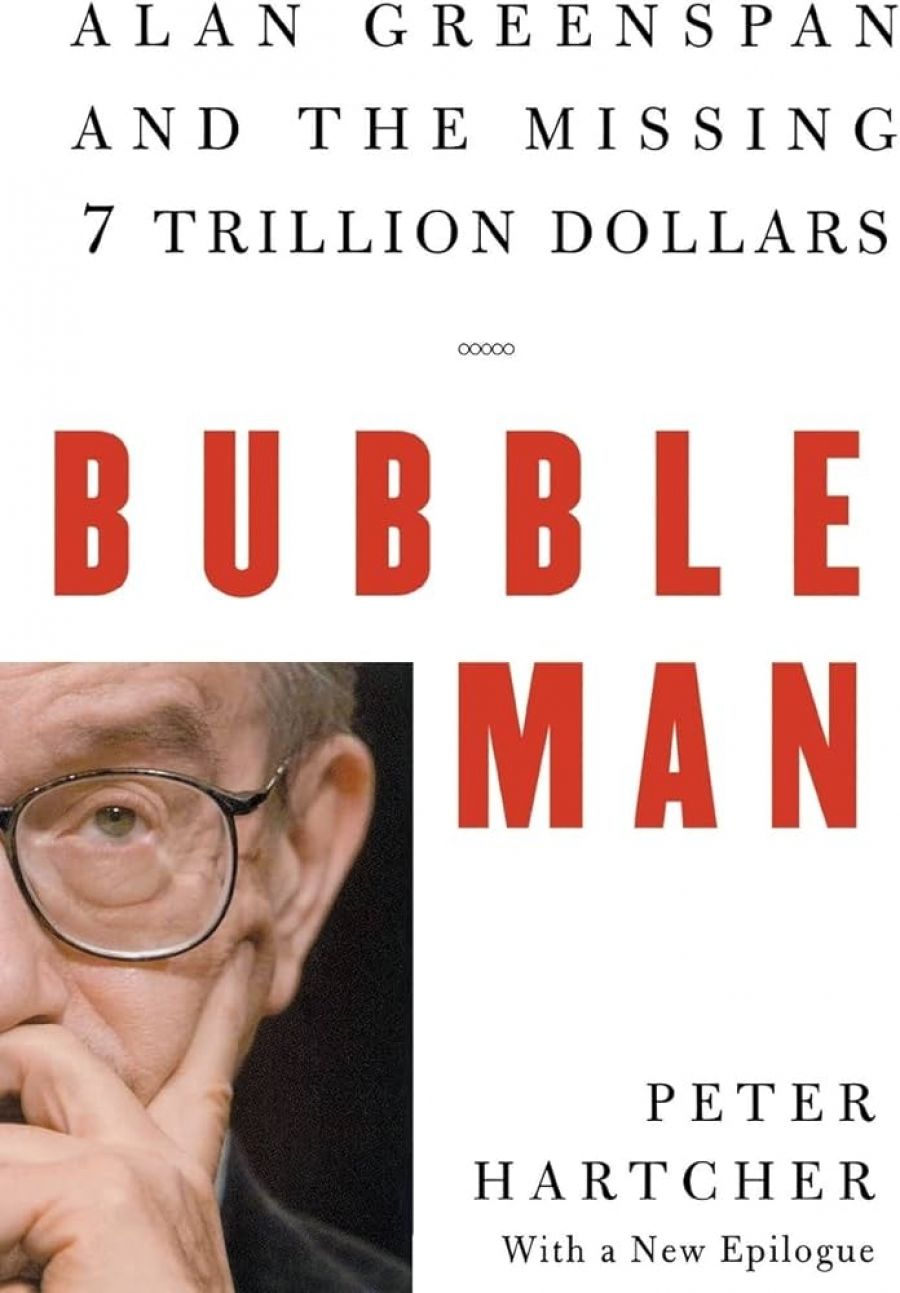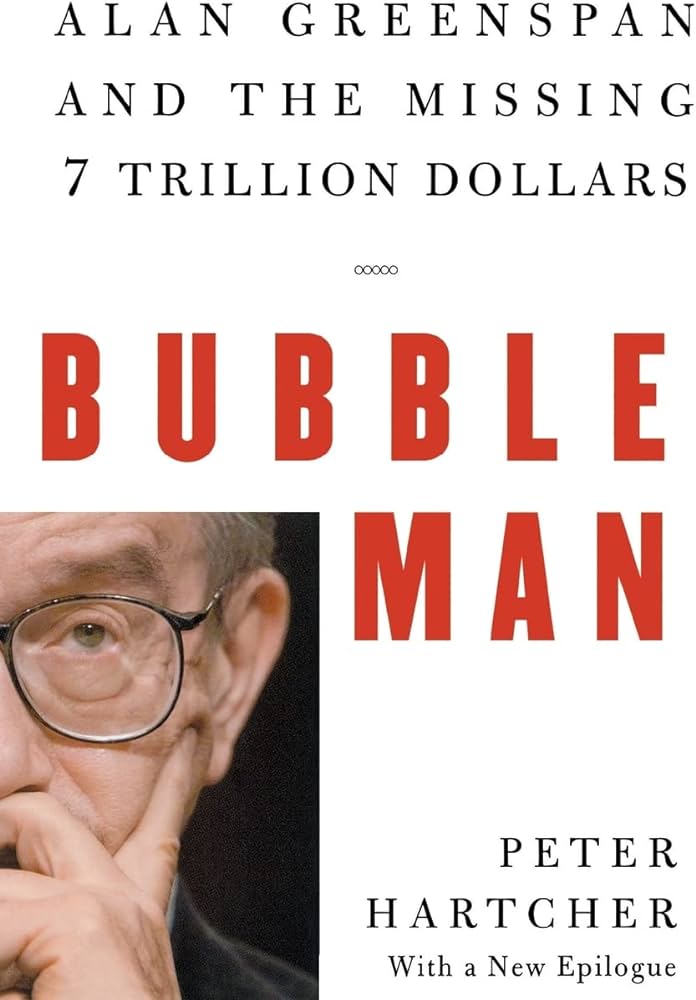
- Free Article: No
- Contents Category: Economics
- Review Article: Yes
- Article Title: The mightiest mania
- Online Only: No
- Custom Highlight Text:
Peter Hartcher has written a terrific book. It is that rarity in Australian publishing: an account of a significant economic event written in language that is totally comprehensible to the non-economist. It is shaped like a true-crime psychological thriller.
The scene of the carnage is the American dotcom bubble, which began to gather pace in 1996 and in time became ‘the mightiest mania in the four centuries of financial capitalism’. When it finally imploded in March 2000, it had wiped out US$7.8 trillion in shareholder wealth, and in the ensuing recession 2.3 million people were thrown out of work. Hartcher accuses the soon-to-retire chairman of the US Federal Reserve, Alan Greenspan, of being one of the principal culprits in this debacle, and his book seeks to justify that verdict and to explore how it came about.
- Book 1 Title: Bubble Man
- Book 1 Subtitle: Alan Greenspan and the missing 7 trillion dollars
- Book 1 Biblio: Black Inc., $27.95 pb, 201 pp
- Book 1 Cover Small (400 x 600):

- Book 1 Cover (800 x 1200):

Unlike Australia’s Reserve Bank, the Fed keeps meticulous minutes of its monthly meetings, which subsequently become publicly available. Having carefully scrutinised these records, Hartcher details the concerns expressed by Greenspan and his board at their meetings as the stock market bubble generated momentum, and contrasts this with the chairman’s reassuring public words, which seemed to fuel the mania. He writes: ‘Even though they knew that it was creating dangerous imbalances and growing risks, even though they spent years fretting about it in private, they never saw fit to utter a peep publicly.’ There was nothing inevitable about the Great American Bubble, and the Fed had within its power the means to dampen its growth, most notably by raising interest rates. However unpopular this may be, an effective central banker is supposed to remove the punchbowl before the party gets too rowdy and threatens to wreck the furniture. This they notably failed to do.
The pivotal moment for Hartcher is the famous speech Greenspan made in 1996, when he referred to the ‘irrational exuberance’ of the market. Within hours, stock markets around the world recorded significant falls. But the US reaction to this fairly subtle act of candour was devastating: Greenspan was lambasted by senior politicians and snubbed by the administration. There were howls of rage from investors, who were really rather enjoying the irrational increase in their wealth.
Hartcher implies, but does not say outright, that Greenspan, who had by then been chairman for nine years, had become seduced by the trappings of fame. As Christopher Hitchens observed in an article in Vanity Fair: ‘He probably does possess more power than any President. A nod from him about the interest rate and global markets quiver along every nerve and ganglion … He doesn’t have to waste time at any ceremonial events. He is obliged to report to Congress only twice a year, and at formal occasions, where he is received with the deference that was once accorded the Emperor of Japan.’ Famously described as Woody Allen with math skills, Greenspan had become the great public guru; he was no longer a man who could be relied on to take a stand against the tsunami of avarice, which would almost certainly have meant falling on his sword. Indeed, not only did Greenspan fail to apply the brakes, he ‘now became the charismatic leader of a manic cult. The last line of defence for sanity and good policy had become the front line of advance for delusion and cupidity. The seer who had challenged irrational exuberance now became its cheerleader.’
Although Bubble Man is a compelling read, in some ways its internal architecture and its marketing are downright odd. Its blurb claims it ‘paints a perceptive portrait of the Fed chairman’, which suggests that it is intended as an informal memoir, but it certainly isn’t that. Hartcher expends a great number of words recapturing the fin-de-siècle madness of the dotcom boom, which, of course, is all good fun, but he finds precious little space to explore the repercussions of Greenspan’s cowardice, or even to justify his book’s rather beguiling subtitle. Yes, $7.8 trillion were wiped off the value of American shares at their dizzy height, but Hartcher quotes at length Jeremy Grantham, whose detailed analysis shows that the collapse of most bubbles, including this one, merely returns assets to their original, and presumably rational, value. On that basis, the much-vaunted $7 trillion are not missing at all – they were merely an illusionary gain that disappeared over time. In fact, the post-bubble recession in the US officially lasted only eight months, so the perceptive reader may well ask where the real harm is. On average, each American man, woman and child lost US$16,000 in the collapse of the bubble, but this figure does not do justice to the mayhem and, in particular, the many personal tragedies of the most naïve people, who were suckered into the vortex of the mania in its later stages and subsequently lost their life savings.
Ultimately, Bubble Man is a profound and troubling book about democracy at work. In some countries – traditionally Germany and Switzerland, but now the new European entity – the central bank is much more independent than it is in the US (or Australia), where the government exerts its influence through its power to nominate board members. But this begs the central ideological conundrum of democracy: if the people are all-knowing and wise, why should we have institutions like the central bank (or the High Court?) that are unresponsive to the day-by-day demagoguery of the people’s representatives?
Alan ‘Bubble Man’ Greenspan did exactly what his politicians and the loudest of their constituents demanded, however ignoble his reasons. Peter Hartcher’s book introduces us to the unfortunate sequelae of that. In doing so, he tells an important story and leaves us struggling for answers.


Comments powered by CComment